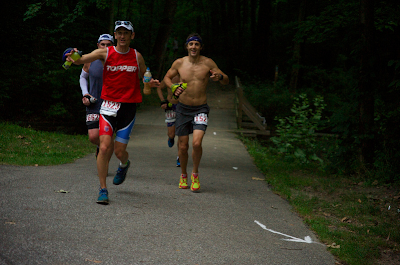Practice makes permanent.
This year's Burning River 100 marked my first 100 mile ultrarun, and therefore my first 100 miler recovery phase. In some ways recovery has occurred surprisingly fast, but in other ways not nearly fast enough. While on a quest to crack the sub-3:00 marathon barrier this fall, my plans have been temporarily reoriented toward a more noble long term goal-- health.
The BR100 race day photographer captured a telling moment of that day that hints at why certain body parts still hurt six weeks later. Forty miles into the race, the outside of my knee was writhing in pain, approximately where my IT band attaches at the outside of the fattest part of the knee. I thought for sure my race would end prematurely but I started popping ibuprofen at mile 50 against my better judgements. I felt terribly conflicted about the whole sacrificing-health-for-performance thing, but I went on to finish the race on ~12 x 200 mg vitamin I (advil) in 21:17, with only a few regrets and lessons learned.
 |
| My left leg went rogue by mile 40. (Steven Pierce Photography) |
It seems obvious, only now, that I had let some mechanical bad habits creep in over the course of the year, likely compounded by compensations for other neglected issues, maybe less obvious than the wonky left foot. I made an appointment to see my physical therapist buddy Eric Oliver at Beyond Exercise. I can't say enough good things about his ability to step back, listen, see the big picture, and then advise.
Eric found all kinds of stuff wrong with me, from my ankles (soccer injuries), to my calves (cycling injuries), to my knee, IT band, quads, glutes, hip flexors, and even scapula. On my first visit, he red-lighted my fall marathon bid and told me I need to REST, heal, and then rebuild my body from the ground up. At this point, there is a temptation to pop the proverbial advil, ignore him, and push through the aches and pains. But I'm really trying to be on board with his plan for a more long-term approach to performance and a better, healthier, balanced body.
I took another two weeks off completely, and showed drastic improvement-- reduced inflammation and soreness, especially. But also a resurrected desire to go hit the trails with reckless abandon. On my second visit, Eric assessed my run mechanics on his treadmill and I'll share his evaluations below.
The primary observations that I noticed are:
1. You exhibit inconsistency with your foot striking—you waffle between a midfoot and rearfoot striker, as exhibited in the two different initial contact images (1a and 1b). The hip, trunk, and knee angles during initial contact are good.
2. Good alignment of body during the loading response and pre-swing phase.
3. During the toe-off phase, your leading leg does not show the optimal knee angulation. There should be more knee bend. This knee bend will shorten the lever arm of your leg and thus allow you to swing it forward more easily. Additionally, more knee bend will better set you up for a midfoot strike.
4. At the speed you’re running, there should be more knee bend at the mid-swing phase. Again, this shortens your lever arm which will both conserve your energy and set you up for a mid-foot strike.
5. All your other joint measurements are within a good range.
6. The rear view shows your “wacky” left leg and foot position as you begin your swing phase. The difference between your left and right foot is obvious, and I’m speculating that it is due to the way your left foot supinates at the end of your stance phase. Biomechanically, this may be due to your talocrural (ankle) joint laxity. There is so much joint play in the talocrural joint that when your foot strikes the ground in a supinated position (this is a normal motion) the ankle stays in supination because the “mortise” part of the talocrural joint is not tight enough to guide the foot back into a neutral and pronation position.
A. Your body may be just fine tolerating this for a certain amount of mileage per given run and weekly gross distance, but eventually there will be break-down of tissue as evidenced with your recurring left knee and foot pain.
B. Your outer ankle ligaments are either just too loose or partially non-existent, and some sort of external support may be necessary to support the ankle in promoting normal biomechanical movement. You will need a support with substantial “squeeze”, such as this one
C. Single leg exercises that force you to pay attention to lower extremity control in an eccentric manner will help, but I’m not sure if it will be enough (ie. Bracing may still be necessary).
Eric then gave me about a dozen exercises to do plus a 45 minute stretching/foam rolling routine. That doesn't leave a whole lot of extra time for bad behavior of logging long miles, but that's OK-- it's almost fall and it's been great to hang out with family and just be a little more devoted to lazy.
Happy healing!













No comments:
Post a Comment